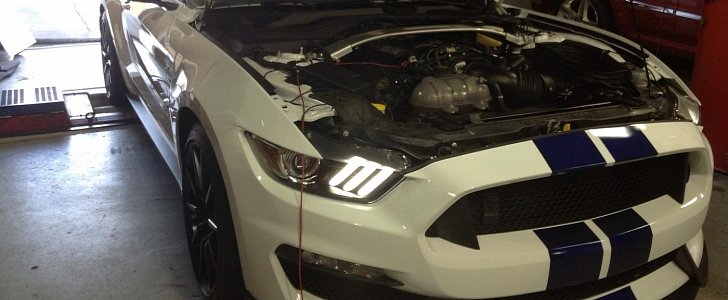With its naturally-aspirated flat-plane crank V8, the Shelby GT350 is quite the opposite of a car that begs to have you massage its engine compartment. Still, the aftermarket world must have its way and this is the reason we’re here for.
Today we want to show you a GT350 that has received some mild engine work, along with the results of its gym-going efforts. And no, this isn’t the first tuned example of the model.
The ‘Stang, which belongs to a Mustang6G forum member, has only spent a few weeks in stock form. We’re talking about a 2016 Shelby GT350 that features the all-important Track Package and comes dressed in Oxford White, with Blue stripes.
The track-friendly pony was taken to DTP Racing in Chesapeake, Virginia, being strapped to a dyno for obvious reasons. The Shelby GT350 received a cold air intake supplied by JLT Performance, as well as an ECU remap.
We have to explain the intake features a five-inch inlet and was specifically designed to fit under the hood of the GT350.
Despite the 5.2-liter Voodoo motivating this Mustang being a naturally aspirated engine, the small upgrades mentioned above allowed the engine to gain 31 horsepower. Aficionados will want to know what happens when only the tune is applied. With just the electronics being massaged, the vee eight gains a predictable 13 hp. It should be mentioned that the new mapping comes from DPC Racing.
Muscle car fans will be pleased to hear what the aftermarket developer had to say about this GT350 - “There isn't a ton left in these car's from Ford, the stock tune is pretty aggressive already.”
We’ll remind you that, since we are talking about a tuned machine, the values mentioned above refer to the power at the rear wheels, not at the flywheel.
While you’ll be able to see the dyno graph in the pic below, you’ll have to look past the messy rpm increase.
The ‘Stang, which belongs to a Mustang6G forum member, has only spent a few weeks in stock form. We’re talking about a 2016 Shelby GT350 that features the all-important Track Package and comes dressed in Oxford White, with Blue stripes.
The track-friendly pony was taken to DTP Racing in Chesapeake, Virginia, being strapped to a dyno for obvious reasons. The Shelby GT350 received a cold air intake supplied by JLT Performance, as well as an ECU remap.
We have to explain the intake features a five-inch inlet and was specifically designed to fit under the hood of the GT350.
Despite the 5.2-liter Voodoo motivating this Mustang being a naturally aspirated engine, the small upgrades mentioned above allowed the engine to gain 31 horsepower. Aficionados will want to know what happens when only the tune is applied. With just the electronics being massaged, the vee eight gains a predictable 13 hp. It should be mentioned that the new mapping comes from DPC Racing.
Muscle car fans will be pleased to hear what the aftermarket developer had to say about this GT350 - “There isn't a ton left in these car's from Ford, the stock tune is pretty aggressive already.”
We’ll remind you that, since we are talking about a tuned machine, the values mentioned above refer to the power at the rear wheels, not at the flywheel.
While you’ll be able to see the dyno graph in the pic below, you’ll have to look past the messy rpm increase.






